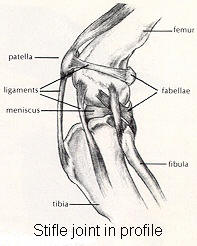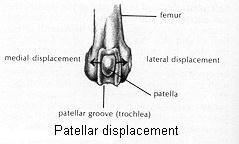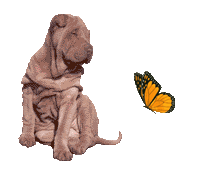|
What the Patella is...What does it do?
- The canine patella
is equivalent to the human knee cap. It is a bony structure that
sits in a groove in the femur (thigh bone) on the front of the
stifle (knee joint).
 Attached
to the patella is the quadriceps tendon and the patellar tendon.
The quadriceps tendon runs from the patella up to the muscle mass
on the front of the thigh and to a lesser extent downover the
patella to the patella tendon. The patella tendon runs from the
patella down to a protuberance on the front of the tibia. Attached
to the patella is the quadriceps tendon and the patellar tendon.
The quadriceps tendon runs from the patella up to the muscle mass
on the front of the thigh and to a lesser extent downover the
patella to the patella tendon. The patella tendon runs from the
patella down to a protuberance on the front of the tibia.
When the muscles
contract, they pull the quadriceps tendon up which pulls the
patella up, which, in turn pulls on the tibia via the patella
tendon. The result of all this pulling is to straighten or extend
the leg.
As the leg is
extended and flexed, the patella rides up and down in the
trochlear groove. Ideally, the groove should be deep enough for
the patella to fit snugly into it. If the tendons, muscles and
bones are all aligned properly, the result is a stable, sound
stifle joint. Improper alignment means instability and this not
only leads to degenerative joint disease, but also places
increased stress on other ligaments and supporting structures.
Back to Top
Medial Patellar Luxation - This condition,
commonly called slipped stifles, results from several
abnormalities of the bones of the hind legs. These include a
shallow trochlear groove and twisting and bending of the femur and
tibia.
Proper joint
function relies on a perpendicular alignment of the quadriceps
tendon, patella and patellar tendon, one right above the other
when viewed from the front. If the upper end of the tibia is
rotated inward, for example, it takes the attachment of the
patellar tendon with it. The alignment is no longer perpendicular
and patella is pulled to the inside (medially).
Medial patellar
luxations (dislocations) can occur in varying degrees of severity
and they have been classified into four grades:

-
Grade I Luxation:
- The stifle joint is
almost normal and the patella luxates only when the leg is
extended and the patella is pushed. When the leg is extended,
there is less tension on the tendons holding the patella in place,
and it is therefore easier to push it out of place. Usually, there
is no gait abnormality, but as the dog gets older, it may develop
arthritis.
Grade II Luxation:- The patella usually
lies loosely in its normal position, but it will luxate medially
with flexion of the joint. These animals have a "hopping" gait.
The patella becomes trapped out of the trochlear groove on flexion
and the dog hops along on the other leg while kicking the sore leg
straight to allow the patella to move back into position. Animals
with Grade II luxation are more likely to develop arthritis that
those with Grade I because of the greater degree of abnormal
patella movement.
Grade III Luxation:- The patella is
dislocated most of the time, but can be put back manually if the
leg is extended.
Grade IV Luxation:- The patella is
dislocated all of the time and cannot be corrected without
surgical intervention. Grades III and IV show varying degrees of
lameness, often the dog assumes a crouched position due to the
inability to fully extend the stifles; often they appear bowlegged
with the toes pointed inward due to deformities in the rear limbs.
Back to Top
-
Lateral Patellar Luxation
- This problem
is less common and is seen most often in large breeds.
Back to Top
-
Surgery
- There are various
techniques for correcting patellar luxation, but all of them are
designed to re-establish the proper perpendicular alignment of the
quadriceps tendon, the patella, and the patellar tendon and to
prevent sideways movement of the patella.
The vet will not
usually recommend surgery for Grade I cases, but surgery becomes
more advisable with the increasing severity.
Back to Top
-
Considerations
- Dogs can have Grade
I or II slipped stifles and move quite normally. As these dogs
become older, either with the breeder or in pet homes, they may
develop lameness. Sold at a young age by an unknowing breeder,
even the Grade II and IV dog can go undetected for awhile. If the
new owner does not recognize the problem in time, severe
degenerative changes can occur that cannot be corrected by
surgery.
The reputable
knowledgeable breeder is the problem in the breed, and aware of
the stifle status of both his and others breeding stock, they know
the consequences of not breeding the problem out, and that
soundness and health are just as important (if not more) as breed
type.
Back to Top
-
Recognising if there is a Problem
- Many well-known
breeders believe that they do not have any problems with slipped
stifles in their kennels. Some do in fact have the problem but
they can't see it. Because all their dogs are walking
around normally, they can see no reason to be concerned. Most
breeders who feel this way probably do not keep their breeding
stock into old age.
If patellar luxation
is ever going to be eliminated, everyone who breeds dogs must know
about the problem and be able to recognize it in their dogs.
As the patella moves
in and out of the trochlear groove, there is a "clicking" feeling.
All you have to do in some dogs is take hold of the back legs, one
in either hand, and raise and lower the back feet off the ground
to feel the clicking. In some breeds show judges may do this while
checking for rear leg straightness, and they should discover
patellar luxation more often this way than trying to feel a loose
patella with the leg on the ground.
If your dog passes
this test, try holding one hind leg in the hock area and
stretching the leg out straight behind. While the leg is fully
extended, twist the hock outwards, turning the toes inward and
holding it in this position, push the leg so as to bend it. If you
feel a "click", it is the patella popping back into the groove.
Detecting very
slight luxations is more difficult and it would be a good idea to
have your vet show you how to push the patella with your thumb
while holding the leg extended.
Back to Top

Site Researched and Produced by
©Kavishi
Shar-Pei
|



